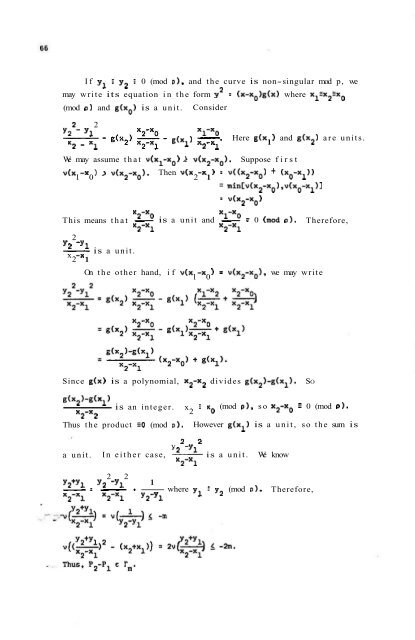You also want an ePaper? Increase the reach of your titles
YUMPU automatically turns print PDFs into web optimized ePapers that Google loves.
If yl  y2  0 (mod p), and the curve is non-singular mod p, wedt)The curve may be parametrized as follows: x = à y = -may write its equation in the form y2 = (x-xo)g(x) where xlEx2Exot t 3(mod p) and g(xo) is a unit. Consider 4where ~(t) = (1 t At t ~ t ~ ) " ~ ~(t) . may be represented as a power2wY2- Yl-= xl-xoseries: ~(t) = 1 t 1 [The series may be derived from theg(xl) Here g(x ) and g(x2) are units.1 i=2 - -"2 - xl1 1 2series (ltu)"'We may assume that v(xl-x) 2 v(x2-x). Suppose firstp-adicly for t  0 (mod p). From the formula for t, we see that tv(x -x ) > v(x-x). Then v(x -x ) = v((x2-xo) + (x-x))1 0 2 1 is the parameter of a point in rm if and only if v(t) 2 m.= min[v(x2-xo) ,v(xo-xl)l= 1 t 5 u - ,. u t & u 3 - . . . I This series convergesThis means that -x2-x12x -X2 1is a unit.= v(x-x)x2-x0 is a unit and"l^o -=0 (mod 0). Therefore,x2-x1On the other hand, if v(x -X ) = v(x2-x), we may write1 0Let P 1' P 2 have parameters tl,t2 resp. Put 5 = e(tl),E = ~ ( t ) nl , = n(P), and n2 = n(P2). Let P3 = P 1 + P2 and haveparameter t3, We need to express the addition law in terms of theparameters; that is, we need t3 in terms of tl and t2.We may assume nl 5 n2.Since g(x) is a polynomial, x2-x2 divides g(x2)-g(xl).g(x)-g(x)is an integer. x 2 xo (mod P), so x2-xo  0 (mod P 1.2x2-X2Thus the product 50 (mod 0). However g(xl) is a unit, so the sum isa unit.£ ÂY -Y1In either case, ÑÑà is a unit. We knowx2-x12 2Y2+Y1 Y2 -Y1 1- = --where y  y (mod p). Therefore,x2-x1 X2-X1 Y2-YlSOIf we let 8 = 1By the addition formula,-- - -y2-y1, we get - =2 3 3t tt1t2tt2^-tl t2 81i=:1 x 2 -X 1 t1t2(t1tt2)The right side of the above may be expressed as a power series usingt ...2 2We know v(tl) j n, v(t2) 2 n, and u(tl tt1t2tt2^) = v(tl ) 2 2n1.2 2Thwçfore v(tlt2(tl ttlt2+t22)) = v(tl)tv(t2)tv(tl ttlt2tt22) 2 3nltn2.(1-u)-1/2 = 1 t F U t ^'
















